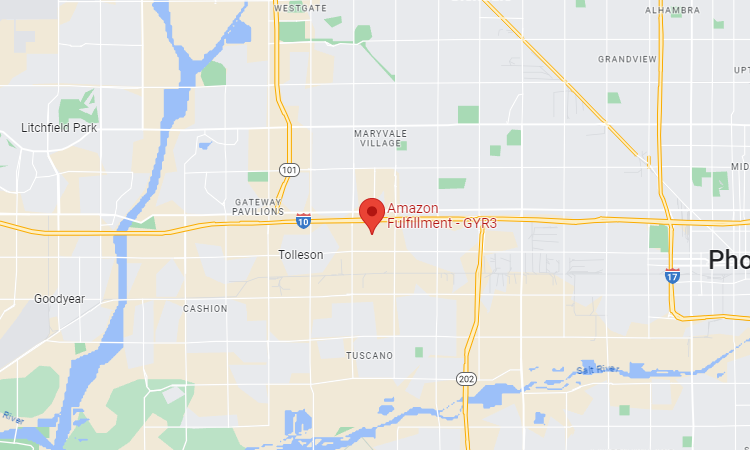If you are an Amazon seller who sources products from China, you may wonder how to ship your goods to Amazon fulfillment centers in the US. In this article, we will introduce one of the Amazon fulfillment centers, GYR3, and explain how to ship your products from China to GYR3 step by step. We will also provide some practical tips and precautions to help you optimize your shipping process and avoid common pitfalls.
What is Amazon Fulfillment Center GYR3?
Amazon fulfillment center GYR3 is located at 8181 W Roosevelt St, Phoenix, AZ 85043, in Maricopa County. It is one of the four Amazon facilities in Arizona and the second one in Phoenix. The facility covers 638,000 square feet and employs 2,200 part-time and full-time workers. It receives and consolidates products from vendors and then ships them to surrounding Amazon fulfillment centers.
GYR3 is a cross-dock center, which means it does not store inventory for long periods of time. Instead, it acts as a transit point for inbound and outbound shipments. Cross-dock centers help Amazon reduce warehousing costs, improve order fulfillment time, and enhance customer satisfaction.

How to Ship from China to Amazon Fulfillment Center GYR3?
The process of shipping from China to Amazon fulfillment center GYR3 can be divided into four main steps:
- Create a shipment plan in Seller Central
- Choose a shipping method and a freight forwarder
- Prepare your goods and documents
- Track your shipment status and deal with any issues
Step 1: Create a shipment plan in Seller Central
The first step is to create a shipment plan in Seller Central. A shipment plan tells Amazon how many units of each product you are sending, where they are coming from, and where they are going. To create a shipment plan, you need to follow these steps:
- Go to Inventory > Manage Inventory and select the products you want to ship.
- Click on Action on selected > Send/Replenish Inventory.
- Enter the ship from the address. It’s important to note that the “Ship from” address is the location from which your shipment will be picked up for final delivery to an Amazon fulfillment center. The location of the Ship From warehouse often determines the location of the Amazon fulfillment center you’re assigned.
- Choose the packing type. You can choose either individual products or case-packed products. Individual products are different items that are shipped together in one box. Case-packed products are identical items that are shipped together in one box.
- Confirm the number of units and cases for each product.
- Print the FNSKU labels for each product and apply them to the units or cases.
- Review your shipment details and approve the shipment.
After you approve the shipment, Amazon will assign you a fulfillment center based on your ship from address and other factors. If you are assigned to GYR3, you will see its address and code on your shipping label.
Step 2: Choose a shipping method and a freight forwarder
The next step is to choose a shipping method and a freight forwarder for your shipment. There are three main shipping methods you can choose from: air express, air freight, and ocean freight.
A freight forwarder is a company that helps you arrange the transportation of your goods from the origin to the destination. A freight forwarder can handle various tasks such as booking cargo space, preparing documents, clearing customs, paying duties and taxes, arranging insurance, tracking shipments, and delivering goods.
Choosing a reliable and experienced freight forwarder is crucial for your shipping success. A good freight forwarder can help you save time, money, and hassle, while a bad one can cause delays, damages, and disputes. Here are some tips to help you choose a good freight forwarder:
- Ask for recommendations from other sellers or your supplier.
- Check the reputation and reviews of the freight forwarder online.
- Compare the quotes and services of different freight forwarders.
- Communicate with the freight forwarder clearly and frequently.
- Verify the credentials and licenses of the freight forwarder.

Step 3: Prepare your goods and documents
The third step is to prepare your goods and documents for shipping. This step is very important because it can affect the speed, safety, and cost of your shipment. You need to make sure that your goods are properly packed, labeled, and palletized, and that your documents are complete and accurate.
Packing
Packing your goods well can protect them from damage, theft, and loss during transit. You need to follow these packing guidelines:
- Use sturdy and durable boxes that can withstand the weight and pressure of your goods.
- Use sufficient cushioning materials such as bubble wrap, foam, or paper to fill the empty spaces and prevent your goods from shifting or colliding.
- Seal the boxes securely with strong tape or glue.
- Do not overpack or underpack your boxes. The boxes should not bulge or sag.
- Do not mix different products or SKUs in one box. Each box should contain only one product or SKU.
Labeling
Labeling your goods correctly can help them get identified, sorted, and delivered to the right destination. You need to follow these labeling guidelines:
- Print the FNSKU labels for each product and apply them to the units or cases. The FNSKU labels are unique identifiers that Amazon uses to track your inventory. You can print them from Seller Central when you create your shipment plan.
- Print the shipping labels for each box and apply them to the outside of the boxes. The shipping labels contain information such as the ship from address, the ship to address, the shipment ID, and the box number. You can print them from Seller Central after you approve your shipment.
- Print the pallet labels for each pallet and apply them to four sides of the pallets. The pallet labels contain information such as the shipment ID, the pallet number, and the number of boxes on the pallet. You can print them from Seller Central after you approve your shipment.
Palletizing
Palletizing your goods can make them easier to load, unload, and transport by forklifts or trucks. You need to follow these palletizing guidelines:
- Use standard wooden pallets that measure 40 inches x 48 inches x 5.5 inches (101.6 cm x 121.9 cm x 14 cm).
- Stack your boxes neatly and evenly on the pallets without any overhang or gaps.
- Do not exceed the height limit of 72 inches (182.9 cm) or the weight limit of 1,500 pounds (680 kg) per pallet.
- Secure your boxes on the pallets with stretch wrap or straps.
- Do not mix different shipments or products on one pallet. Each pallet should belong to one shipment and contain only one product or SKU.
Documents
Preparing your documents properly can help you clear customs smoothly and avoid any delays or penalties. You need to prepare these documents:
- Commercial invoice: This document shows the details of your transaction such as the seller’s name and address, the buyer’s name and address, the description and value of the goods, the terms of sale, and the payment method.
- Packing list: This document shows the details of your shipment such as the number and weight of packages, the dimensions of packages, the marks and numbers of packages, and the description and quantity of goods.
- Bill of lading: This document shows the details of your transportation such as the shipper’s name and address, the consignee’s name and address, the carrier’s name and address, the origin and destination ports, the vessel name and number, the container number and seal number, and the description and quantity of goods.
- Certificate of origin: This document shows where your goods were manufactured or produced. It may be required by some countries to determine if your goods are eligible for preferential tariffs or duties.
- Other documents: Depending on your product type and destination country, you may need other documents such as a fumigation certificate, an inspection certificate, a health certificate, or a safety data sheet. These documents are usually required for products that are subject to special regulations or standards, such as food, cosmetics, chemicals, or batteries. You should check with your supplier, your freight forwarder, or the customs authorities of your destination country to find out what documents you need for your shipment.
Step 4: Track your shipment status and deal with any issues
The last step is to track your shipment status and deal with any issues that may arise during transit. You can track your shipment status through Seller Central, your freight forwarder’s website, or the carrier’s website. You should monitor your shipment status regularly and be prepared to handle any problems that may occur.
Some of the common issues that you may encounter are:
- Delays: Your shipment may be delayed due to various reasons such as bad weather, port congestion, customs clearance, or carrier errors. You should contact your freight forwarder or carrier to find out the cause and the estimated time of arrival of your shipment. You should also update your inventory settings in Seller Central to avoid overselling or running out of stock.
- Damages: Your goods may be damaged during transit due to improper packing, handling, or accidents. You should inspect your goods carefully when you receive them and report any damages to your freight forwarder or carrier as soon as possible. You should also file a claim for compensation if you have purchased insurance for your shipment.
- Losses: Your goods may be lost during transit due to theft, misplacement, or misdelivery. You should verify the tracking information and the delivery confirmation of your shipment and report any discrepancies to your freight forwarder or carrier immediately. You should also file a claim for compensation if you have purchased insurance for your shipment.
- Fees: You may incur additional fees for your shipment due to various reasons such as dimensional weight, fuel surcharge, customs duties and taxes, storage fees, demurrage fees, or delivery appointment fees. You should review the invoice and the breakdown of the fees from your freight forwarder or carrier and pay them promptly. You should also avoid any actions that may trigger extra fees, such as changing the delivery address, requesting special services, or missing the delivery appointment.
Conclusion
Shipping from China to Amazon fulfillment center GYR3 can be a complex and challenging process, but it can also be rewarding and profitable if you do it right. By following the steps and tips we have shared in this article, you can optimize your shipping process and avoid common pitfalls. We hope this article has helped you understand how to ship from China to Amazon fulfillment center GYR3 and make your cross-border e-commerce business more successful.



